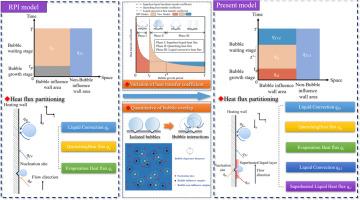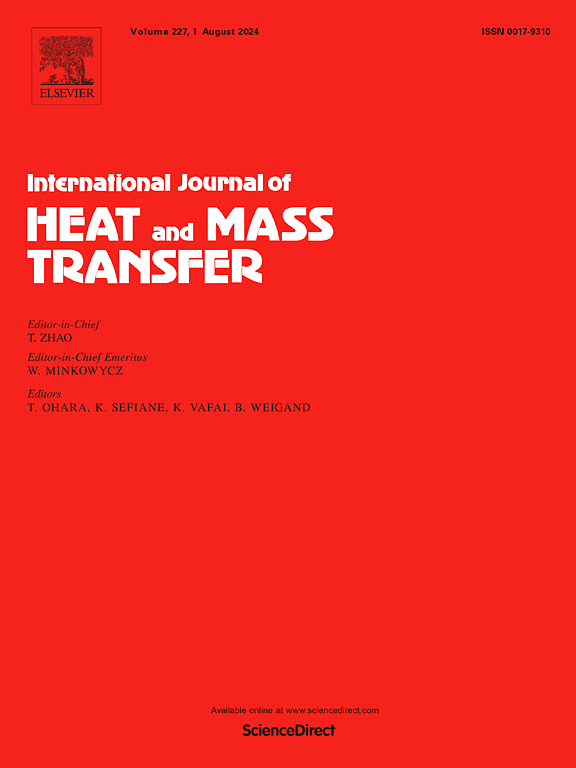Investigation of bubble interaction in a temporal and spatial heat flux partitioning model for subcooled flow boiling
IF 5
2区 工程技术
Q1 ENGINEERING, MECHANICAL
International Journal of Heat and Mass Transfer
Pub Date : 2024-11-08
DOI:10.1016/j.ijheatmasstransfer.2024.126389
引用次数: 0
Abstract
CFD methodology for subcooled flow boiling is significantly affected by the heat flux partitioning model, which plays a crucial role in predicting the mass source term generated by wall boiling of the liquid phase. Although numerous models have been proposed, most research efforts have focused on the spatial dimensions of boiling heat transfer mechanisms, neglecting the temporal aspect. This study presents a heat flux partitioning model for subcooled flow boiling that considers both temporal and spatial dimensions. The model accounts for the contribution of heat flux from the superheated liquid layer during the bubble growth stage, liquid convection during the bubble wait stage within the bubble influence area in the temporal dimension, and heat flux from the overlapping area of bubble influence in the spatial dimension. An approach was developed to determine the bubble influence area by considering the bubble interaction based on the stochastic nature of nucleation sites on the heated wall, verified by the Monte Carlo method. The bubble dynamics parameters were experimentally derived to reduce the uncertainty associated with the boiling sub-models on the calculation. A comparative analysis of boiling curves and wall heat flux partitioning was conducted between the present model and the RPI model under various flow conditions. The results indicate that both models could reasonably predict the boiling curve. However, the RPI model tends to over-predict the proportion of evaporative heat flux, which is considered a weakness. Based on physical principles, the present model accurately captures the fundamental trend of wall heat flux partitioning. This research enhances the understanding of subcooled flow boiling and increases confidence in multiphase CFD methodology predictions.

过冷流沸腾时空热通量分配模型中的气泡相互作用研究
过冷流沸腾的 CFD 方法受热流分区模型的影响很大,该模型在预测液相壁面沸腾产生的质量源项方面起着至关重要的作用。虽然已经提出了许多模型,但大多数研究工作都侧重于沸腾传热机制的空间维度,而忽略了时间方面。本研究提出了一种同时考虑时间和空间维度的过冷流动沸腾热通量分配模型。该模型在时间维度上考虑了气泡生长阶段过热液层的热通量贡献,气泡等待阶段气泡影响区域内的液体对流,以及空间维度上气泡影响重叠区域的热通量。根据加热壁上成核点的随机性,开发了一种考虑气泡相互作用的方法来确定气泡影响区域,并通过蒙特卡罗方法进行了验证。气泡动力学参数通过实验得出,以减少沸腾子模型在计算中的不确定性。对本模型和 RPI 模型在各种流动条件下的沸腾曲线和壁面热通量分配进行了比较分析。结果表明,两种模型都能合理预测沸腾曲线。然而,RPI 模型倾向于过度预测蒸发热通量的比例,这被认为是一个弱点。本模型基于物理原理,准确捕捉了壁面热通量分配的基本趋势。这项研究加深了人们对过冷流动沸腾的理解,增强了对多相 CFD 方法预测的信心。
本文章由计算机程序翻译,如有差异,请以英文原文为准。
求助全文
约1分钟内获得全文
求助全文
来源期刊
CiteScore
10.30
自引率
13.50%
发文量
1319
审稿时长
41 days
期刊介绍:
International Journal of Heat and Mass Transfer is the vehicle for the exchange of basic ideas in heat and mass transfer between research workers and engineers throughout the world. It focuses on both analytical and experimental research, with an emphasis on contributions which increase the basic understanding of transfer processes and their application to engineering problems.
Topics include:
-New methods of measuring and/or correlating transport-property data
-Energy engineering
-Environmental applications of heat and/or mass transfer

 求助内容:
求助内容: 应助结果提醒方式:
应助结果提醒方式:


